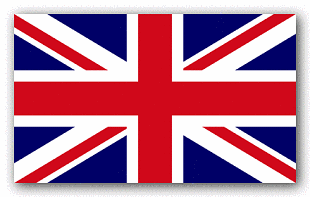FLAG FLYING ETIQUETTE: All flags, including the Union Flag and those of England, Scotland, and Wales, should always be displayed in a manner which is befitting of the country’s national emblem.
Improper Use of National Flags
National Flags should never be treated with indignity. They should always be flown without inferiority to any other flag.
This conforms to the proper flag etiquette while aloft and waving free without interference.
Displaying any of the National Flags as a mask to cover cartons, boxes, or barriers is improper and disrespectful. Large banners should not be used to drape over a table or seat cover.
The same protocol applies to bridging the space between floor and ground level on a dais (low stage), platform, or podium.
The flags of England, Scotland, and Wales should not be used to cover a monument or large statue, as a rule. Shrouding a plaque before an unveiling ceremony is bad practice at the least, and horribly distasteful at the worst.
Proper flag flying etiquette in the United Kingdom means they should always be flown in good condition. In other words, avoid flying them in a dilapidated or damaged state.
Always replace soiled representations. This shows the uttermost respect for each nation’s dignitaries and its citizens.
Flag Etiquette UK
UK flag flying rules regulate when, and how, you fly flags in the United Kingdom.
- As a rule, flags should be flown between the hours of sunrise and sunset.
- Flags should have appropriate illumination (better by spotlight) at all times if they get displayed at night.
- No permission is usually required to fly the National Flags and they have explicit exclusion from planning regulations.
- Nonetheless, flagpole permission is not always excluded from council planning rules in the United Kingdom.
Position of Honour
Due precedence and consideration should always go to flag flying etiquette and protocol in the United Kingdom. This is even more so for any display of the UK’s National Flags (or sovereign national flags).
There are times when the aim of your presentation will be for decoration only. In this case, it may be more appropriate to confine the display to flags of lesser status. Examples could include pennants, buntings, or coloured
house flags.
Precedence of Flags in the United Kingdom
The accepted order of precedence of flags in the United Kingdom is:
- Royal Standards
- The Union Jack Flag (flown the correct way up)
-
The Constituent National Flag of the home
country (England, Scotland, or Wales) - Flags of other nations (in English alphabetical order)
- The flag of the European Union
- Flags of counties
- Flags of cities or towns
- Banners of arms
- House flags

International Flag Flying Protocol
All international flags should have the same width when National Flags are flown with those of other nations. The classification of this is the measurement from top to bottom. Each flag should fly from a separate flagpole. It is
very important that all the flagpoles are of the same height.
International flag flying protocol prohibits the flying of any nation’s flag higher than another in peacetime. The exception would be for medal ceremonies during sporting events. Square shaped flags can have a larger width (up
to 125%) to balance the equal surface area.
As a rule, the most senior National Flag should get raised first and lowered last. The exception could be whereby they can all get raised and lowered at the same time.
Flying the British Flag Protocol
In general, all flags should get raised briskly and without delay. When they get lowered it should take place in a ceremonious fashion.
A typical British flag flying tradition is to hoist it while rolled and tied off with a thin piece of cotton. Then, tugging sharply on the slip knot (halyard) breaks the cotton and releases the flag.
The freeing technique is officially referred to as ‘breaking the flag‘. It is a common practice used to symbolize the beginning of a ceremonious event. Breaking the flag also occurs as a mark of respect for the
arrival of a VIP or international dignitary.

